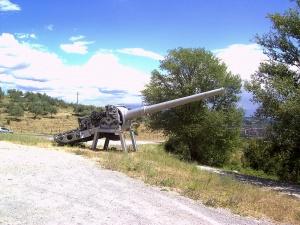152/53 mm O.T.O. Mod.1929 (152 mm)
Contents
Description
Write an introduction to the article in 2-3 small paragraphs. Briefly tell us about the history of the development and combat using the weaponry and also about its features. Compile a list of air, ground, or naval vehicles that feature this weapon system in the game.
Vehicles equipped with this weapon
General info
Tell us about the tactical and technical characteristics of the cannon or machine gun.
Available ammunition
Describe the shells that are available for the weapon and their features and purpose. If it concerns autocannons or machine guns, write about different ammo belts and what is inside (which types of shells).
Comparison with analogues
Give a comparative description of cannons/machine guns that have firepower equal to this weapon.
Usage in battles
Describe the cannon/machine gun in the game - its distinctive features, tactics of usage against notable opponents. Please don't write a "guide" - do not impose a single point of view, but give the reader food for thought.
Pros and cons
Summarise and briefly evaluate the weaponry in terms of its characteristics and combat effectiveness. Mark pros and cons as a list.
Pros:
Cons:
History
The 152 mm /53 Model 1926–1929 were built for the Italian Navy in the years before World War II. These guns were used on all Condottieri-class light cruisers except the Duca degli Abruzzi-class.
The Model 1926 was designed and manufactured by Ansaldo, while the Model 1929 was manufactured by OTO Melara. Although both models of gun were similar in construction, components from each manufacturer were not fully interchangeable.
| Commonalities:
|
Differences: |
|---|---|
|
|
|
|
|
|
|
The gun mounts had electrically powered training, elevation, hoists, rammers and the guns shared a common cradle. Improvements in ammunition handling meant that the rate of fire for the Model 1929 was nearly twice as fast as the Model 1926. Loading was at +20° for the Model 1926, while the model 1929 could be loaded at any angle up to 45°. These guns suffered from dispersion problems so the original muzzle velocity of 1,000 metres per second (3,300 ft/s) was reduced to 850 metres per second (2,800 ft/s) with AP shells. Shell weight was also reduced from 50 kilograms (110 lb) to 47.5 kilograms (105 lb) in an attempt to resolve these problems, but were only partially successful. The main reason for the dispersion problem was because the guns were mounted too close together on a common cradle, which also complicated loading of the guns.
The majority of the Condottieri-classes had two superfiring twin-mount turrets forward and aft, except for the Duca degli Abruzzi-class which had different model guns and had two twin-turrets replaced with two triple-turrets. The Giussano-class carried Model 1926 guns, while the Cadorna-class, Montecuccoli-class and Duca d'Aosta-class carried Model 1929 guns. The mountings for the Giussano-class and Cadorna-class were found to be too lightly built for the recoil forces created by these guns.
Ammunition[edit]
Ammunition was of quick fire separate loading type. The AP projectile was 63 centimetres (2.07 ft) long with a cartridge case and a bagged charge which weighed 21.43 kilograms (47.2 lb).
The gun was able to fire:
- Armor Piercing (early) - 50 kg (110 lb)
- Armor Piercing (late) - 47.5 kg (105 lb)
- High Explosive - 44.3 kg (98 lb)
Media
See also
Visit:
Cruisers equipped with this gun:
External links
In-depth history of said gun:
| USSR naval cannons | |
|---|---|
| 20 mm | ShVAK |
| 25 mm | 2M-3 |
| 30 mm | AK-230 · 30 mm/54 AK-630 · BP "Plamya" |
| 37 mm | 37 mm/67 70-K · V-11 |
| 45 mm | 45 mm/46 21-K · 45 mm/68 21-KM · 45 mm/89 SM-20-ZIF · 45 mm/89 SM-21-ZIF |
| 57 mm | AK-725 |
| 75 mm | 75 mm/50 Canet patt.1892 |
| 76 mm | 34-K · 39-K · 76 mm/60 AK-176M · AK-726 · D-56TS · F-34 · Lender AA gun, pattern 1914/15 |
| 85 mm | 85 mm/52 92-K · 85 mm/54.6 ZIS-C-53 · 90-K |
| 100 mm | 100 mm/56 B-34 · 100 mm/70 SM-5-1 · Minizini |
| 102 mm | Pattern 1911 |
| 120 mm | 120 mm/50 pattern 1905 |
| 130 mm | 130 mm/55 pattern 1913 · 130 mm/58 SM-2-1 · B-13 |
| 152 mm | 152 mm/57 B-38 |
| 180 mm | 180 mm/57 B-1-P · 180 mm/60 B-1-K |
| 305 mm | 12-inch/52 pattern 1907 · 305 mm/54 B-50 |
| Foreign: | |
| 40 mm | 2pdr QF Mk.IIc (Britain) · Skoda (Czechoslovakia) |
| 47 mm | 3 pdr QF Hotchkiss (Britain) |
| 76 mm | 76 mm/40 Ansaldo mod.1917 (Italy) |
| 88 mm | SK C/30 (Germany) |
| 120 mm | 120 mm/50 Mk.4 Bofors M1924 (Sweden) · 120 mm/50 O.T.O. Mod.1933 (Italy) |
| 152 mm | 152/53 mm O.T.O. Mod.1929 (Italy) |
| 320 mm | 320 mm/44 Ansaldo model 1934 (Italy) |




